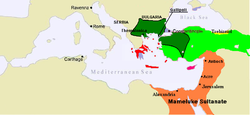State of the Circassians | |||||||||
|---|---|---|---|---|---|---|---|---|---|
| 1382–1517 | |||||||||
|
Flags according to the Catalan Atlas of c. 1375 | |||||||||
| Attributed arms of the Mamluk Sultan (by Mecia de Viladestes map, 1413) | |||||||||
 | |||||||||
| Status | Sultanate under the Abbasid Caliphate | ||||||||
| Capital | Cairo | ||||||||
| Spoken languages | Arabic Circassian[1] Turkic[2] | ||||||||
| Religion | Sunni Islam | ||||||||
| History | |||||||||
• Established | 1382 | ||||||||
• Disestablished | 1517 | ||||||||
| |||||||||
The Burji Mamluks (Arabic: المماليك البرجية, romanized: al-Mamalik al-Burjiya) or Circassian Mamluks (Arabic: المماليك الشركس, romanized: al-Mamalik al-Sharkas), sometimes referred to as the Burji dynasty,[3][4] were the rulers of the Mamluk Sultanate of Egypt from 1382 until 1517. As with the preceding Bahri Mamluks, the members of the Burji Mamluk ruling class were purchased as slaves (mamluks) and manumitted, with the most powerful among them taking the role of sultan in Cairo. During this period, the ruling Mamluks were generally of Circassian origin, drawn from the Christian population of the northern Caucasus.[5][6][7][8] The name Burji, meaning 'of the tower', refers to the traditional residence of these Mamluks in the barracks of the Citadel of Cairo.[5][9][10]
Although sultans typically designated their sons to succeed them after death, the latter rarely lasted more than a few years before being usurped by one of the powerful Mamluk commanders, usually from among the Mamluks purchased by previous sultans.[5] Political power-plays often became important in designating a new sultan.[11]
During this period, the Mamluks fought Timur and conquered Cyprus. Over the course of the 15th century, the sultanate was weakened by infighting and economic decline brought about by multiple factors. Although militarily powerful, they were eventually unable to compete with the more modern army of the Ottoman Empire, leading to their eventual conquest in 1517 by the Ottomans.[11]
- ^ Fischel 1967, p. 72.
- ^ Yosef, Koby (2013). "The Term Mamlūk and Slave Status during the Mamluk Sultanate". Al-Qanṭara. Consejo Superior de Investigaciones Científicas. 34 (1): 7–34. doi:10.3989/alqantara.2013.001.
- ^ Shoup, John A. (2017). The Nile: An Encyclopedia of Geography, History, and Culture. ABC-CLIO. p. 170. ISBN 978-1-4408-4041-8.
- ^ Flood, Finbarr Barry; Necipoğlu, Gülru (2017). A Companion to Islamic Art and Architecture. Wiley Blackwell. p. 579. ISBN 978-1-119-06857-0.
- ^ a b c Bosworth, C. E. (1996). "The Mamluks". New Islamic Dynasties: A Chronological and Genealogical Manual. Edinburgh University Press. pp. 76–80. ISBN 978-1-4744-6462-8.
- ^ McGregor, Andrew James (2006). A Military History of Modern Egypt: From the Ottoman Conquest to the Ramadan War. Greenwood Publishing Group. p. 15. ISBN 9780275986018.
By the late fourteenth century Circassians from the north Caucasus region had become the majority in the Mamluk ranks.
- ^ Isichei, Elizabeth (1997). A History of African Societies to 1870. Cambridge University Press. ISBN 978-0-521-45599-2.
- ^ Heng, Geraldine (2018). The Invention of Race in the European Middle Ages. Cambridge University Press. ISBN 978-1-108-42278-9.
- ^ Petry, Carl F. (2014). The Civilian Elite of Cairo in the Later Middle Ages. Princeton University Press. p. 18. ISBN 978-1-4008-5641-1.
- ^ AlSayyad, Nezar (2013). Cairo: Histories of a City. Harvard University Press. p. 117. ISBN 978-0-674-07245-9.
- ^ a b Petry, Carl F. (2022). The Mamluk Sultanate: A History. Cambridge University Press. pp. 23–52. ISBN 9781108471046.


